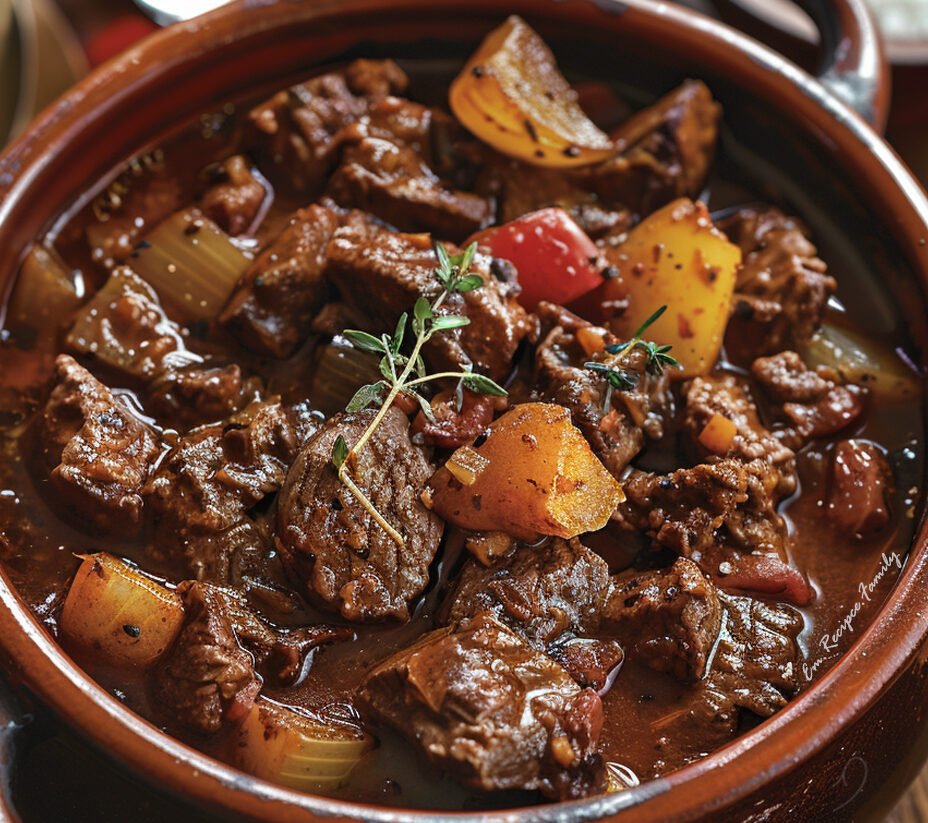
German Goulash: A Hearty, Flavorful Hug in a Bowl!
Hey there, Jason Griffith here! When the weather cools down or you’re just craving a meal that wraps you in warmth and rich flavor, there’s nothing quite like a well-made goulash. And this German Goulash recipe? It’s the epitome of comfort food – tender stewing beef simmered in a luscious, deeply savory sauce brimming with paprika, red wine, and aromatics. It’s a dish that tastes like it cooked all day, but with surprisingly straightforward steps. Get ready to fall in love with this robust and incredibly satisfying classic!
Why I Love This Recipe
I’m a big proponent of slow-cooked dishes that develop incredible depth of flavor, and this German Goulash truly delivers. What I particularly love about this recipe is the way the humble stewing beef transforms into fork-tender perfection, soaking up all the rich spices and liquids. The Hungarian paprika is key here, providing not just color but a beautiful, smoky-sweet warmth, while the red wine adds a sophisticated layer of complexity. It’s the kind of meal that makes your kitchen smell amazing and brings everyone eagerly to the table. Plus, it’s perfect for making ahead, as the flavors only deepen with time.
Ingredients
Here’s what you’ll need to create this deeply satisfying German Goulash:
- 1 1/2 pounds stewing beef, cut into 1/2 to 1-inch chunks (chuck roast or beef round work well)
- 1 tablespoon oil (vegetable or olive oil)
- 1 large yellow onion (about 400 g or 14 oz), diced
- 2 cloves garlic, minced
- 1 cup dry red wine (e.g., Cabernet Sauvignon, Pinot Noir, or Merlot)
- 3 tablespoons tomato paste
- 3 tablespoons Hungarian paprika (sweet or hot, depending on preference)
- 1/2 teaspoon dried marjoram
- 1 teaspoon salt
- 1/2 teaspoon freshly ground black pepper
- 2 cups beef broth
- 1 bay leaf
- 2 teaspoons cornstarch dissolved in 2 tablespoons water (or more, depending on desired thickness)
Swaps and Notes
- Stewing Beef: Choose beef cuts suitable for slow cooking, like chuck roast, beef round, or stew meat. Cut them into even chunks for consistent tenderness.
- Onions: The large amount of diced onion might seem like a lot, but they cook down significantly and contribute essential sweetness and body to the sauce.
- Red Wine: A dry red wine adds fantastic depth. If you prefer to cook without alcohol, you can substitute with an equal amount of beef broth, though the flavor profile will be slightly different.
- Hungarian Paprika: This is crucial! Hungarian paprika (especially sweet paprika) is vital for authentic goulash flavor and color. Regular paprika won’t give the same depth.
- Herbs: Dried marjoram is traditional; dried thyme can be a substitute if needed.
- Cornstarch Slurry: The cornstarch and water mixture (a slurry) is used to thicken the sauce at the end. Adjust the amount based on how thick you like your goulash. You can also use a flour roux at the beginning if you prefer.
- Spice Level: If you like a little heat, use hot Hungarian paprika or add a pinch of cayenne pepper.
Instructions
Making German Goulash involves a few steps, but it’s largely hands-off simmering time, letting the flavors develop beautifully.
- Brown the Beef: Heat the oil in a deep, heavy skillet or Dutch oven over medium-high heat. Add the stewing beefin batches if necessary, ensuring not to overcrowd the pan. Brown the beef on all sides until a nice crust forms. This step is crucial for flavor. Transfer the browned beef to a plate and set aside.
- Sauté Aromatics & Deglaze: Add the diced yellow onion to the same skillet (don’t clean it; those browned bits are flavor!). Cook until the onions are lightly browned and softened, about 6-8 minutes, stirring occasionally. Add the minced garlic and cook for another minute until fragrant. Pour in the dry red wine, bring it to a boil, and reduce the heat. Simmer steadily until the wine has evaporated by about half, which should take 3-4 minutes, scraping up any browned bits from the bottom of the pan as it simmers.
- Build the Sauce: Stir in the tomato paste, Hungarian paprika, dried marjoram, 1 teaspoon salt, and 1/2 teaspoon freshly ground black pepper with the onions and reduced wine. Cook for another minute, stirring to combine everything well. Return the browned beef to the skillet and pour in the beef broth. Add the bay leaf.
- Simmer and Tenderize: Bring the mixture to a boil, then immediately reduce the heat to low. Cover the skillet or Dutch oven tightly and simmer gently for about 1 hour, or until the beef is very tender and easily pierced with a fork. Check occasionally to ensure it’s not sticking, and add a splash more broth if needed.
- Thicken the Sauce: Once the beef is tender, remove the bay leaf. Stir the cornstarch dissolved in water into the goulash. Stir constantly to prevent lumps and continue to simmer for a minute or two until the sauce has thickened to your desired consistency.
- Final Seasoning: Taste the goulash and add additional salt and pepper to taste if needed.
Serving and Enjoying
German Goulash is meant to be a hearty, comforting meal. It’s traditionally served over various sides that can soak up its rich sauce. Your choice of accompaniments includes:
- Spätzle (German egg noodles)
- German Potato Dumplings
- German Bread Dumplings
- Boiled potatoes
- Simple egg noodles (like wide egg noodles)
This recipe makes 4 large or 6 smaller servings, perfect for a family dinner or leftovers!
Tips for Success
- Brown the Beef Well: Don’t rush this step! A good sear on the beef adds deep, savory flavor (the Maillard reaction) to the goulash.
- Use Hungarian Paprika: Seriously, it makes a difference. Its rich color and unique flavor are essential for authentic goulash.
- Low and Slow Simmer: Patience is key for tender beef. Keep the heat low and let it gently simmer, not aggressively boil.
- Adjust Thickness: If you prefer a thicker sauce, you can add a bit more cornstarch slurry. If it’s too thick, thin it with a splash of hot beef broth or water.
- Taste and Adjust: Always taste your goulash before serving and adjust salt, pepper, and even a bit more paprika or marjoram if you feel it needs it.
Storage and Leftover Tips
Goulash is one of those magical dishes that often tastes even better the next day as the flavors continue to meld. Store leftover German Goulash in an airtight container in the refrigerator for up to 3-4 days. To reheat, gently warm on the stovetop over low heat, adding a splash of beef broth or water if the sauce has thickened too much. It also freezes beautifully for up to 3 months; thaw in the refrigerator overnight before reheating.
More Recipes You Will Love
If you appreciate the hearty, comforting flavors of this German Goulash, you’ll love exploring some of my other warming and savory recipes:
- For another soulful, slow-cooked dish, try my This Cajun Chicken Sausage Gumbo Is My Favorite Bowl of Southern Comfort.
- If you’re a fan of rich pasta dishes that feed a crowd, my Classic Spaghetti Recipe with Homemade Sauce is a timeless favorite.
- For a super easy and comforting one-pan meal, check out my This Instant Pot Lasagna Is My Favorite Way to Make Comfort Food Fast.
- And for another simple yet delicious skillet meal, my This Tomato Skillet with Okra and Sausage Is My Favorite Quick Dinner Packed with Southern Flavor is a fantastic choice.
- Finally, if you love tender chicken in a rich sauce, my These Chicken Enchiladas Are My Go-To for Cozy Crowd-Pleasing Dinners are a must-try.
Final Thoughts
This German Goulash isn’t just a recipe; it’s an invitation to cozy up and savor a truly delicious and deeply flavorful meal. The tender beef, the rich paprika sauce, and the simple satisfaction it brings make it a dish you’ll want to revisit again and again. Give it a try, and let this comforting classic become a new favorite in your home!
What’s your favorite traditional European comfort food? Share your ideas and feedback in the comments below, and don’t forget to follow Chef Maniac for more delightful and inspiring recipes!




Leave a Reply